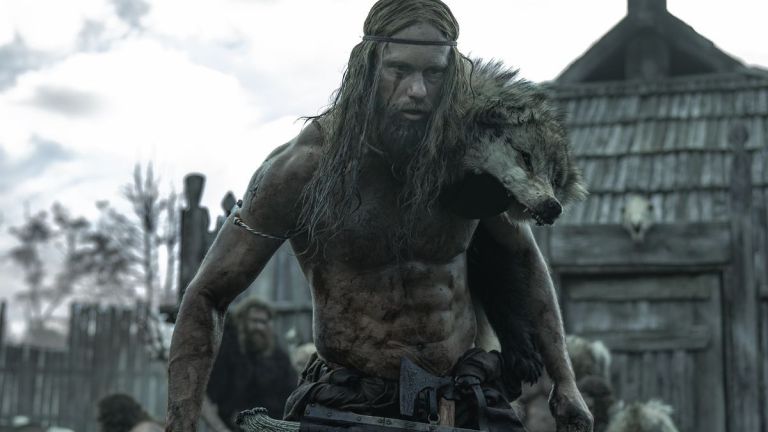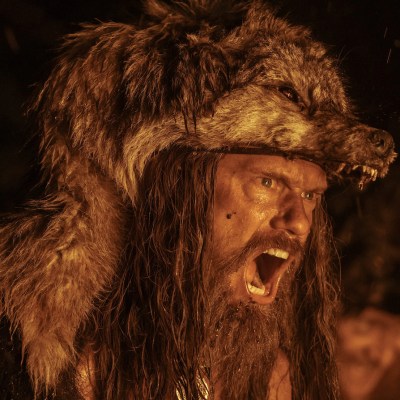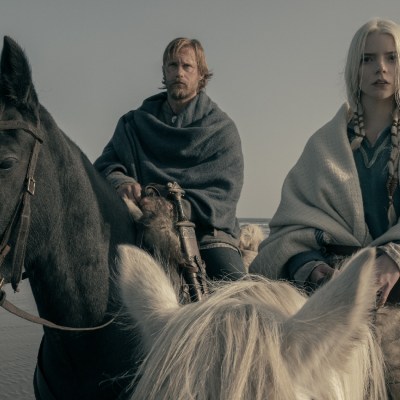The Northman: Why Alexander Skarsgard Refuses to Glorify Vikings
Alexander Skarsgård on how he and Robert Eggers immersed themselves in Viking customs from shipbuilding... to the levels of brutality pop culture often avoids.

Everything in the buildup to The Northman’s Viking raid scene is real. Out in the river shallows of what is supposed to be medieval Europe, an ancient vessel that was once the fear and scourge of villages from North America to modern day Russia is gliding upstream—and it’s gaining speed. Among its many rowers with bloodlust on his mind is Alexander Skarsgård as Amleth, a wayward Viking prince who has lost his kingdom but never his purpose. He rides for glory and for battle, for blood and for vengeance.
And on a location shoot for a Robert Eggers movie, Skarsgård doesn’t have to try too hard to live in that moment. After all, he and all the other actors on that vessel are riding a genuine bow-to-stern recreation of the iconic Viking longship. Even the nails hammered in to keep the boards together are true to archaic Norsemen custom. Again, this is a Robert Eggers movie.
“His attention to detail is extraordinary,” Skarsgård muses when we catch up with him ahead of The Northman’s release, “to the point where not only the longship but a smaller vessel that was used for transporting goods that you’d see deep in the background, way out to sea [was also authentic]. Rob was adamant that it be built in the exact way a vessel like that would’ve been a thousand years ago—the right craftsmanship, the right type of wood. And obviously people who had to foot the bill were like, ‘It’s way out there! Do we really need it?!’ And he’s like, ‘Yup!’”
As with The Witch and The Lighthouse before it, Eggers’ The Northman attempts to breathe the same historical air of its period setting. It’s why despite some protestations from the marine coordinator, the Viking movie’s production took those longship recreations out into open water off the Iceland coast, and up that aforementioned river with Skarsgård at the oar. (We previously asked Eggers if he got down there to row with Alex; he just laughed and said it’s good to be the director.)
“It was surprisingly easy to get that thing moving quickly,” Skarsgård says with a smile. “But it took some practice to get all the rowers in sync, to make it look like we’ve been doing this for months and years. So we definitely spent some time training on that.”
The sequence in question is Skarsgård’s big entrance into the film. Before this moment, we’ve only known his Amleth character as a young boy who barely survived by the skin of his teeth a coup that took his father’s life and made his uncle king. But when we find him now in the bowels of a shallow longship, the look on his face is no longer one of innocence.
“That was technically quite a difficult shot,” Skarsgård recalls, “because the camera starts out on land but it comes out on the water and ends on a close-up, and it’s in one shot as we’re rowing the ship down the river. So the timing was very difficult to get right. It took some practice, but it was a really great day on set.” The kind of day that Skarsgård always dreamed of making happen ever since he first approached Eggers about making a Viking movie.
Indeed, Eggers’ most grand-scaled film to date was not the director’s original idea. That credit belongs to Skarsgård who, hailing from Sweden, was raised on the legacy of Viking sagas and histories.
“I grew up with our country house in southern Sweden being surrounded by runestones,” the actor says. “So I’ve been fascinated by Vikings and that culture and that mythology since I was a kid.”
However, after playing a Viking of sorts on the HBO series True Blood, Skarsgård became drawn to the idea of doing a straight Viking movie. On that TV show, he portrayed a vampire who was first transformed into the undead a millennia ago when he was a Viking from the north. And in several episodes, Skarsgård got to depict that history via flashbacks that, while not historically accurate, burrowed the idea of doing this for real into the performer’s head. So getting one glance at how Eggers depicted Puritans in his first film was enough to intrigue the Swedish actor with a passion project.
“When we started working together, he hadn’t done The Lighthouse,” Skarsgård explains. “He had just released The Witch, and I was quite fascinated by how he incorporated the supernatural into the story and how the characters don’t react to it the way a modern day audience would. That got me really excited, because Rob could capture that in a Viking setting with Viking characters, and their relationship to the spiritual world and gods.”
Indeed, one of the great strengths in all three of Eggers’ films is how they immerse viewers in not only an authenticity of production design, but also the psychology of their cultures. Unlike most modern historical dramas, Eggers does not seek to insert a 21st century worldview into his characters; rather he trusts modern audiences to draw their own conclusions by witnessing archaic and even alien thought processes from previous generations. It gets to what Skarsgård, who is also a producer on The Northman, always wanted for his own Viking movie.
Says the actor, “I was fascinated by the distinction between the natural and the supernatural, and how there was no distinction for the Vikings like there is for us. I was really fascinated by that aspect, and the opportunity to try to portray that to an audience in 2022, who will view it like a fantasy, but to the characters living it, experiencing it, it’s 100 percent real.”
The desire for authenticity also walked hand-in-hand with a need to get away from how Viking culture has been romanticized in media and co-opted by fringe political movements often filled with racial prejudices. This can range from The Northman escaping from the biker punk aesthetic associated with Vikings in mass media thanks to projects like the History Channel’s Vikings TV series and the Assassin’s Creed Valhalla video game, to how the film also depicts the violence and cruelty of that culture.
Take the aforementioned raiding sequence that is set in an Eastern European village. In the film, after sailing within striking range of this Slavic community, Amleth and many of his fellow warriors spend the evening taking hallucinogens to hype themselves into a psychedelic berserker rage—the literal origin for the word “berserk”—and attack the next day devoid of armor or clothes beyond bear and wolf skins on their backs (with each warrior believing he has spiritually shifted shape into the animal of his choice).
They then massacre all the men in the town in a stunning long-take that precedes the same characters indulging the spoils of war: women and children, slaves and victims.
“We wanted to be brutal and visceral, and to show a more realistic depiction of these battles than what most people are used to,” says Skarsgård. “Vikings have been glorified. They were also intrepid explorers, and there’s a complexity to them and to their culture. But to shy away from the brutality of these attacks would be, to me, not only wrong but quite dangerous.”
Hinting at how Viking culture has been glamorized, and appropriated, the actor suggests it’s important to show the totality in an unflinching way to viewers, including what they might do to conquests who were too young or too old to work.
“It was important to do a vast amount of research on how they fought, the strategy behind it, the purpose behind it, and a big commodity was slavery,” says Skarsgård. “Just as it was important to not portray these fighters as heroic gods from the North.”
Despite the harshness of their customs, Skarsgård and Eggers both seem to hope The Northman offers a glimpse into a world that is often discussed but little understood, and provide a rousing adventure that celebrates the beauty of this age as much as its ferocity. Right down to those nails in those oh, so expensive vessels.
“Those ships were integral to the success of the Vikings when they traveled around the world,” Skarsgård marvels. “Not only were they stable and fast, but they were very shallow, so they could do surprise attacks like what you see at the beginning of the movie. They could go up shallow rivers with tremendous speed and attack villages who never expected a warship to come because they’d never seen anything like that before.”
The villagers may have never seen such a sight, but after The Northman’s release, a lot more modern moviegoers will be aware, and maybe a little warned.
The Northman opens in U.S. theaters on April 22. It is now playing in the UK.


